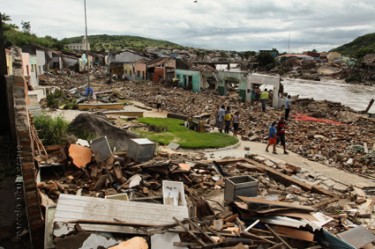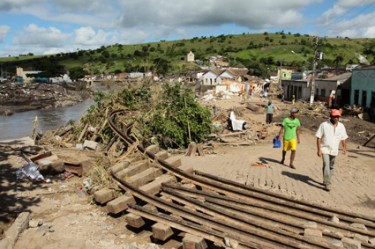At least 46 people were killed and an estimated hundreds remain missing since Friday June 18, after torrential floods swept through the neighboring states of Alagoas and Pernambuco, north-east Brazil, in the worst environmental tragedy in the local population's memory. Dubbed the ‘northeastern tsunami, the floods have been compared to similar catastrophes in Asia, such as the 2004 Indian Ocean tsunami.
At least 180,000 people have been displaced by the disaster, with many finding shelter in schools, churches or with family members. Most people have lost everything they had and rely now solely on humanitarian help. The delay in the arrival of aid means that people are going hungry and sick.
From Santana do Mundau, one of the most affected cities in Alagoas, a citizen reporter recorded the moment the flood took the city last Friday. YouTube user TheWelligton1 shot the video from the roof of his house:
After having lost everything, Teresa Aragão[pt] has published pictures of the destruction around her and celebrates to be alive, safe and sound after the biggest catastrophe she has seen in her city, Palmares (Pernambuco). She has been also using her own blog to provide local news and coordinate donations for those in need especially those with disabilities:
A maior catástrofe que eu já presenciei aqui na minha cidade. a maior enchente de todos os tempos!!! Toda a minha família perdeu tudo!!!estamos sem roupas , documentos e sem remédios também.Graças a Deus não houve mortes na família. O desespero está grande , um verdadeiro caos de lama e amontoados,carros virados submersos…destruiçaõ total.
According to Gilvan Júnior, a month's worth of water was dumped on the affected areas in less than a week – June is normally the wet season in Brazil, but this volume of precipitation was not foreseen:
Na capital alagoana, a expectativa era que chovesse 298,3 milímetros (mm) durante todo o mês, mas até ontem (22) foram registrados de 470,2 mm. Em Recife, choveu 456,7 mm até a manhã de hoje (23), enquanto eram esperados 388,9 mm em todo o mês.
Some small towns have been almost completely destroyed by the floods, while entire communities by the banks of Mundau and Capibaribe rivers, in Alagoas and Pernambuco respectively, were completely washed away. Collapsed bridges and flooded roads left many towns cut off; there is no electricity, fresh water or telephone services in most places affected. Lays describes the desolate picture in Alagoas [pt], including the situation in Branquinha, one of the poorest cities in the country, that has suffered over 90% of destruction and will need to be rebuilt in a different location:
Em cidades como Branquinha e Quebrangulo não restou um só prédio público de pé. Não há postos de saúde, mercadinhos ou farmácias que possam dar uma ajuda emergencial à população. Essas cidades terão que ser reconstruídas por completo, visto que também nenhuma documentação restou nos cartórios de registro públicos.

"It is estimated that 70% of the city of Quebrangulo, 115 km from the capital of Alagoas, Maceió, was destroyed by the Paraíba River waters". Photo Marcelo Albuquerque, used with permission.
The blogosphere is devasted by the news of floods of this magnitude in an area already wrecked by extreme poverty. However, it was the news that the main cause of the disaster was not just the adverse weather conditions but the environmental destruction that left many angry. Alcides Faria [pt] has taken the opportunity to send a message to a local politician who defended some controversial environment policies:
Como todos sabem, o ocorrido em Alagoas também está relacionado ao desmatamento e à não proteção das microbacias. A vegetação marginal de córregos, lagoas e rios é essencial para conter o assoreamento e a crescida rápida do nível das águas.
Many bloggers have published information on how to help. Solidarity networks start to appear offline and online, such as SOS Alagoas, a website that uses OpenStreetMaps to map the most affected areas and to provide information about donation centres. Bloggers brace together in setting up an emergency topic blogging to raise awareness about ways to help.
Décio Junior [pt] says that the images reminds him of the Tsunami in Indonesia and the earthquake in Haiti. While everyone is thinking about the World Cup in South Africa, he tries to catch people's attention to more urgent matters:
Mas não há diferença para a mãe natureza, não há hiato, não há desigualdade. A tragédia pode acontecer para John ou pra João.
E é uma pena ter que repetir esta retórica, mas preciso de alguma maneira contagiar todos os tocedores nesta corrente pelo Brasil.Vamos juntos, tudo é um só coração, um só povo irmão. Pra frente Brasil, salve seus filhos, salve seus irmãos.
For Mother nature, there is no difference, no hiatus, no inequality. The tragedy may happen to João or to John. It is a shame to keep repeating this discourse, but I need to find a way to encourage everyone to join this solidarity network for Brazil.
Let's go together, we have just one heart, one brotherhood. Ahead, Brazil. Save your sons, save your brothers.
After a few fairly dry days, the rainy weather that has plagued the area over the last several days will not come to an end, at least for a while. According to the National Weather Service, the rain forecast for the next days could cause rivers and streams in the area to rise again, and make it difficult for rescue teams to reach affected areas.
The areas affected are part of the northeastern Brazil, a region wracked by extreme poverty and normally affected by extreme dry weather and drought. Floods, however, have become a recurrent annual disaster: in May 2009, at least 44 people were killed and 380,000 displaced in the same areas.










5 comments
hello dear reader,
a quick note to say that an international chipin page has been set to receive paypal donations, please help if you can, either donating yourself or spreading the word.
http://sosalagoas.chipin.com/sos-alagoas
Alagoas is a beautiful and marvelous place, with warm and friendly people. It is one of the places I myself have been very happy living.
love,
Paula
I can completely feel the pain of Brazilians in the flood after the same huge flood. Hold on!
And we know the real challenges come after the flood, which many aboriginal tribes in Taiwan are still facing: losing family, no jobs, no roads, no houses….